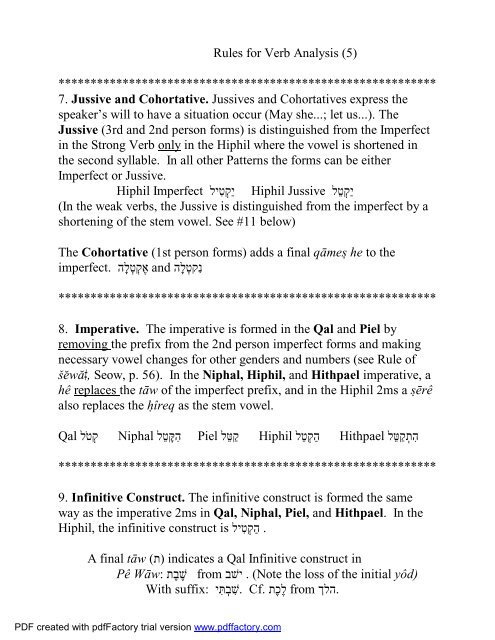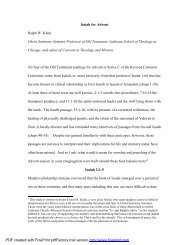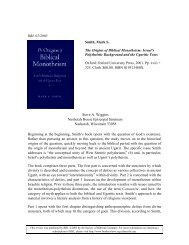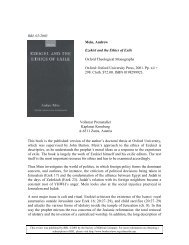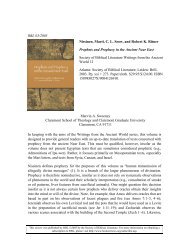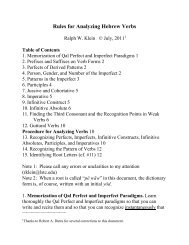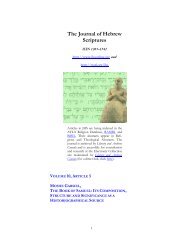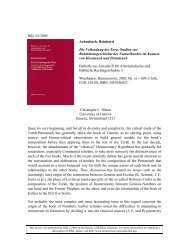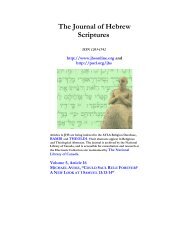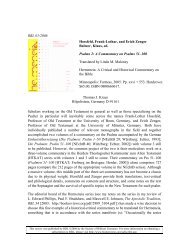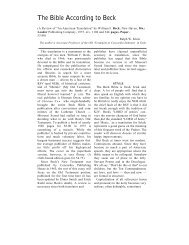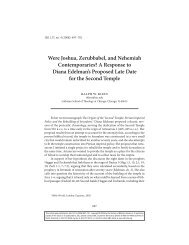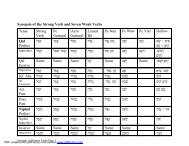Rules for Analyzing Hebrew Verbs
Rules for Analyzing Hebrew Verbs
Rules for Analyzing Hebrew Verbs
Create successful ePaper yourself
Turn your PDF publications into a flip-book with our unique Google optimized e-Paper software.
<strong>Rules</strong> <strong>for</strong> Verb Analysis (5)<br />
***********************************************************<br />
7. Jussive and Cohortative. Jussives and Cohortatives express the<br />
speaker’s will to have a situation occur (May she...; let us...). The<br />
Jussive (3rd and 2nd person <strong>for</strong>ms) is distinguished from the Imperfect<br />
in the Strong Verb only in the Hiphil where the vowel is shortened in<br />
the second syllable. In all other Patterns the <strong>for</strong>ms can be either<br />
Imperfect or Jussive.<br />
Hiphil Imperfect ליטִקְיַ Hiphil Jussive לטֵקְיַ<br />
(In the weak verbs, the Jussive is distinguished from the imperfect by a<br />
shortening of the stem vowel. See #11 below)<br />
The Cohortative (1st person <strong>for</strong>ms) adds a final qāmes. he to the<br />
imperfect. הלָטְקְאֶ and הלָטְקנִ<br />
***********************************************************<br />
8. Imperative. The imperative is <strong>for</strong>med in the Qal and Piel by<br />
removing the prefix from the 2nd person imperfect <strong>for</strong>ms and making<br />
necessary vowel changes <strong>for</strong> other genders and numbers (see Rule of<br />
šĕwă , Seow, p. 56). In the Niphal, Hiphil, and Hithpael imperative, a<br />
hê replaces the tāw of the imperfect prefix, and in the Hiphil 2ms a s.ērê<br />
also replaces the h.îreq as the stem vowel.<br />
Qal לטֹ קְ Niphal לטֵקָּ הִ Piel לטֵּ קַ Hiphil לטֵקְהַ Hithpael לטֵּ קַ תְ הִ<br />
***********************************************************<br />
9. Infinitive Construct. The infinitive construct is <strong>for</strong>med the same<br />
way as the imperative 2ms in Qal, Niphal, Piel, and Hithpael. In the<br />
Hiphil, the infinitive construct is ליטִקְהַ .<br />
A final tāw (ת) indicates a Qal Infinitive construct in<br />
Pê Wāw: תבֶשֶׁ from בשׁי . (Note the loss of the initial yôd)<br />
With suffix: יתִּ בְ שִׁ. Cf. תכֶלֶ from ךלה.<br />
PDF created with pdfFactory trial version www.pdffactory.com


